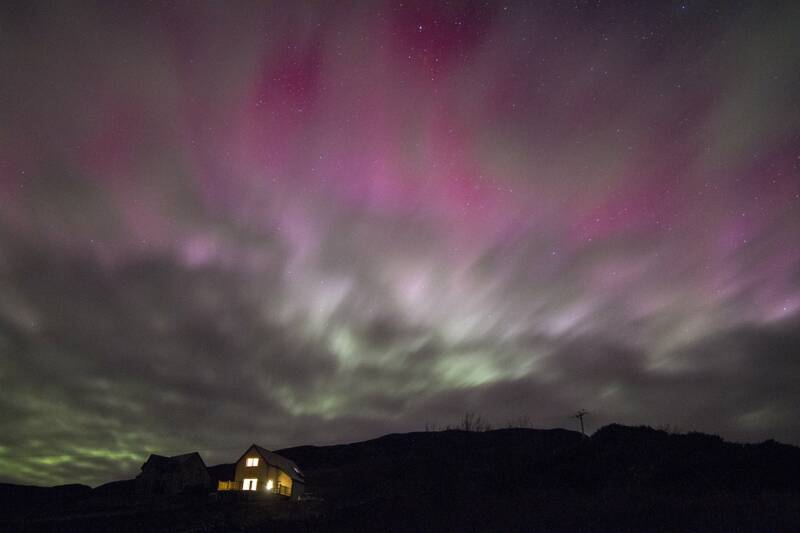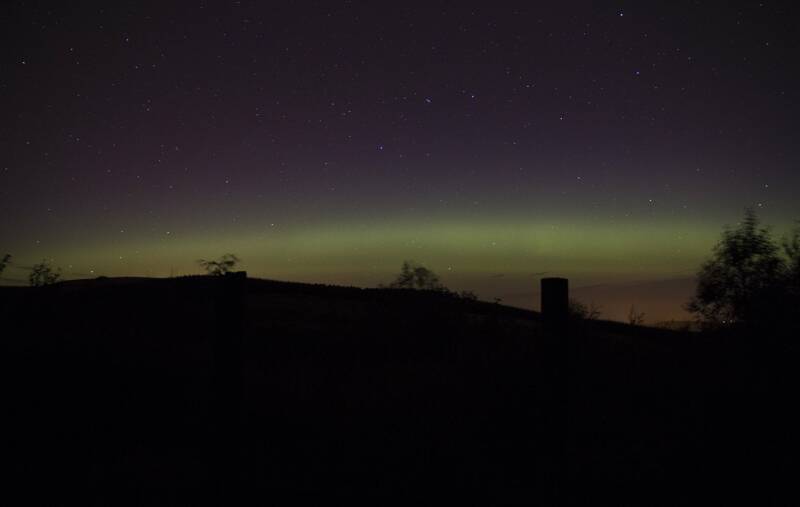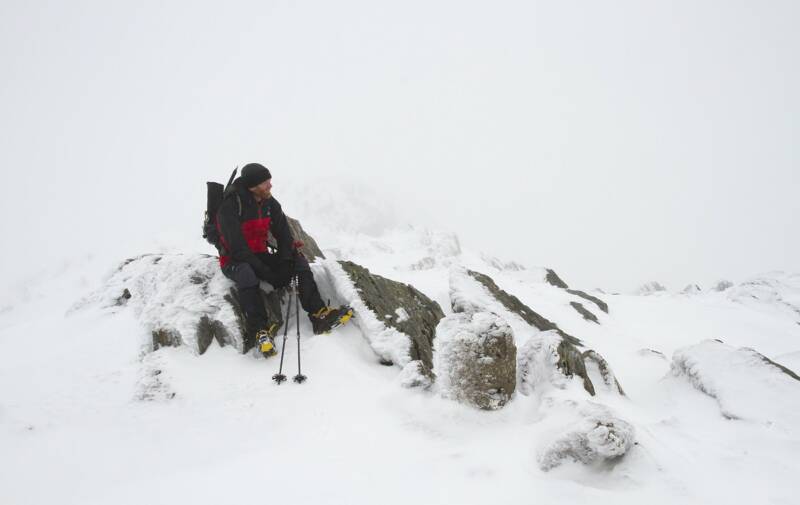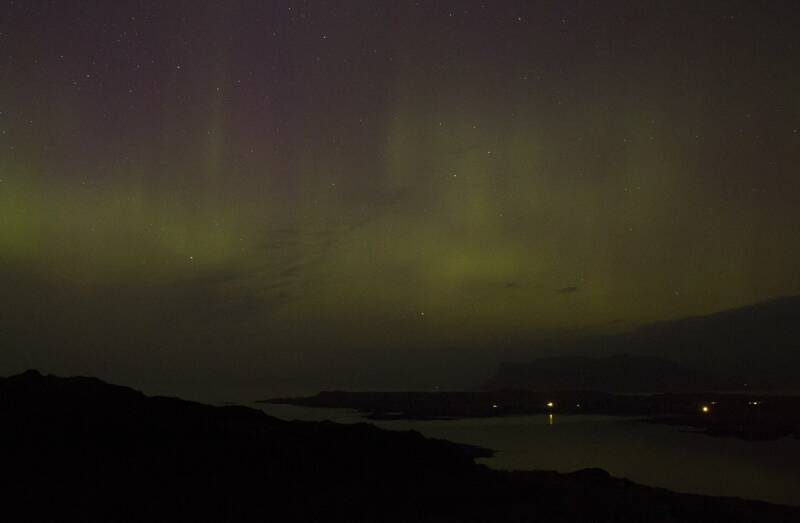
If any four words can make me spill my mug of tea on my legs as I leap up from the sofa, it’s these. If any four words can, in so doing, make me scald my delicates without stopping to check they’re okay, it’s these. If any four words can have me tripping over the death-trap of boots at the front door as I stumble blindly outside into the darkness whilst screwing my camera to its tripod with one hand, tying my laces with the other and simultaneously trying to pull a woolly hat down over my head…..yep, it’s these.
RED ALERT: AURORA LIKELY!
In reality they don’t actually come through in CAPITALS or with an exclamation mark. Those only exist in my head. But yes, four wee words, sent from the University of Lancaster’s ‘AuroraWatch’ to thousands of devices up and down the land, no doubt prompting similar panicked scenes in living rooms from the Solway to Shetland.

AuroraWatch (other fine purveyors of aurora alerts are available) ping yellow and amber alerts out too, depending on the intensity of the ‘space weather’ that reaches us from the sun and thus creates the aurora, but when you’re as far south as we are, a red alert is ideally what you’re after.
I am, of course, caught completely off guard when a real-time alert comes through. My camera is never where I left it, and once found I then encounter one of the following problems: a) it has the wrong lens fitted, b) the battery is flat, or c) the memory card is full. More typically, it’s all of the above.
A night with the dancing Aurora Borealis is supposed to be inspiring. Majestic. Joyous! But up to that point the whole process is incredibly stressful.
The frenzied panic is however justified, for the aurora can quickly subside. There’s a real chance you’ll miss it if you don’t get out as soon as you receive an alert although, in Scotland, getting out the house in good time is the least of your problems.
In our soggy grey corner of the world, red alerts are only slightly more elusive than clear skies. It doesn’t matter if it’s an eclipse, a meteor shower or an aurora, you can bet good money there’ll be some gloomy stratus out there with your name on it.
But even if skies are clear, your location on the map really does matter. In a red alert, which are vanishingly infrequent, the aurora is likely to be seen fairly clearly across the whole of Scotland, but the farther north you are, the more intense it will appear and the higher in the sky it will be. That’s why, where I stay in Fife, if there’s a yellow alert (minor activity) it won’t be worth me getting out of my chair. Shetlanders however, might think otherwise.
Proper darkness matters too of course, but while light pollution from urban areas certainly doesn’t help matters, even during red alerts you’d be surprised what’s visible from our larger towns and cities. Even so, it’s better to be far away from light pollution, and it’s important to give your eyes time to adjust if you’ve just left a bright environment.
Your night vision improves with every passing second, but the longer you give it, the better. Ten good minutes makes a marked difference but I’d recommend at least 20 minutes after you’ve stepped out of the bright interior of a house. And yes, I’m afraid you really must resist the urge to glance at your phone during this time. Also, don’t do what I once did and position yourself near a dark rural road. Your phone, or the headlights of a passing car, can easily undo all your fine efforts.
Finally, a view of the northern sky is rarely sufficient in itself. You need to have an UNOBSTRUCTED view of the northern sky, because unlike in climes much farther north, the aurora doesn’t generally appear directly overhead.
I still remember heading out on my first aurora hunt at home in Fife, naively scanning the northern sky towards the Lomonds, my head angled sharply upwards. I couldn’t see anything.

Confused and disappointed, I drove to the northern side of the Lomond Hills and yep, there it was – a wide green arc, barely higher in the sky than the distant and very modest Sidlaw Hills. In much of Scotland, even during a strong storm, the aurora is found much lower on the horizon than you might think.
Considering all of the above variables, unless you’re very lucky you’ll likely have to relocate yourself to somewhere better suited to night sky viewing. All of which is surmountable with enough time and effort. But in the time it takes to relocate, the aurora may well subside.
When the last big storm hit in October 2021 I was unusually fortunate to be on holiday on the Craignish peninsula in Argyll. Clearly, that’s not far enough north for my liking, but frankly, nowhere in Scotland is ever far enough north for someone with as wintry a disposition as mine. But it was easily one of the darkest places I’ve visited in Scotland and the cottage had such a clear view to the north that I only needed to step just outside the north-facing door, let my eyes adjust and……there it was.
At this point it’s important to say that the vivid photos you see on BBC Scotland the next day – puffed-up jackets standing silhouetted against a luminous green glow, looking skyward in awe with their arms stretched out – aren’t what most folk actually see.
The human eye is generally pants at perceiving colours in low light so, much of the time, the forms and patterns themselves might be more readily discernable than the colour, which can appear more grey than green. Nevertheless, even in those conditions you can tell there’s something there because the sky seems to be shifting and undulating like curtains in a breeze, and it can also fluctuate and shimmer surprisingly quickly.
However, depending on the aforementioned variables, if you’re well positioned and the activity is intense, you can definitely see strong colour in the really good displays. Even from places like Edinburgh, but more so if you’re way up north.
At Craignish it was a happy combination of darkness, intensity and location. Even in the first few seconds after I stepped out the front door I could see it. Initially it just looked like cloud but it quickly grew more obvious as it moved, appearing more like someone flashing a massive spotlight into the sky over towards Oban. It did take a good while for my eyes to adjust, but once they had, it was definitely there above the horizon, it was definitely green and it was definitely moving.

It was one of the better displays I’ve seen, but probably my most memorable was at Bunessan on the Ross of Mull in 2015. On that occasion I still had to clamber up a wee rocky knoll to get the clear view north across Loch Scridain, but from that modest vantage point I could clearly see muted shafts of green dancing over Ardmeanach. I also got the sense, albeit little more than a suggestion, that there was a different shade of bluey-black filling a greater area of the sky above it. And on occasion, a soft purple would visibly appear. None of it was especially vivid but it was there and it was obvious.
That’s a far cry from most of the amber (moderate activity) displays I’ve stumbled out to view in the Central Belt, where you wouldn’t necessarily know what you were looking at unless someone told you. This partly explains my other half’s only-fleeting interest when, having been outside for half an hour already, I shout excitedly indoors that yes, it’s visible and he should come out to look. He knows full well that the next thing I‘ll say, two minutes after he’s joined me outside and has told me he can’t see anything, is that he’ll need more time to let his eyes adjust.
In the cold clasp of night, he mulls it over and quickly (and some would say quite reasonably) comes to the conclusion that if two minutes standing outside in the darkness isn’t sufficient to see the northern lights, then it really can’t be that impressive after a further 18. It’s hard to argue with that, but so long as you don’t go expecting to find a scene straight out of The Polar Express, then you’ll be less likely to be disappointed.
You’ll also be less likely to be disappointed if you’re patient. Just because you can’t see anything at first, even after your eyes adjust, that’s not to say that you won’t see something later. The aurora can intensify and diminish repeatedly throughout the night.
There’s little quite as disheartening as giving up after 90 minutes, only to discover the next morning that had you waited just 15 more minutes you’d have been successful. But that’s the trouble with any of these ‘sit outside and wait’ things that Scotland’s climate is so infuriatingly unsuited to. When do you call it a day?
You’re ultimately governed by your own personal tolerance for sitting around doing nothing. That’s right, nothing. Because remember, you can’t go glancing at your phone.
My personal advice would be to give it as long as you can. Not because that means you’ll definitely find what you’re looking for, rather because it’s just as likely that you won’t, and in so doing you’ll inadvertently find something else entirely.
It’s very much like lingering on a foggy mountain summit, willing the fog to lift in order to reveal the majestic view you know is there. You know the odds are against you but the occasional, fleeting moments of brighter grey overhead mean you can’t bring yourself to leave JUST IN CASE it happens.
A few years ago I sat on top of Beinn Resipol, in a misty but surprisingly benign whiteout for two and a half hours for this exact reason. There was no wind at all, and occasionally it would snow very lightly under the weirdly bright sky. All wrapped up, toasty and warm, I spent an age watching individual snowflakes landing peacefully on my jacket. I took photos of boulders in the mist. I sipped coffee. I listened to the feathery whoosh of ravens passing by. I even chatted to the one other person who ventured up there that day.

I very much doubt I’d have sat there for that long if I’d known the fog definitely wouldn’t lift. But when I finally did stand up to make down the hill, it didn’t feel like wasted time at all. The pleasure had been in the sitting. In the watching. In just…..being.
I dunno. Maybe you do have to be predisposed to sitting around in order to fully commit to these kinds of pursuits but, if anything, the night sky offers so much more than a foggy hill ever could.
Satellites drift by, and as your eyes adjust, countless stars normally hidden by impatience slowly fade into sight. If the sky is completely clear, the Milky Way arcs overhead in a massive brush stroke. I’ve also seen more shooting stars while waiting for an aurora than I can possibly count. Some of them seriously big and flamey! When else do you spend enough time outside on a cold, dark night, not looking at a screen, to be able to see such things? Yes, spectacles can be spectacular. But the waiting room is often just as satisfying.

But suppose you still can’t see anything after you’ve had an alert through, as the sky is dark and featureless. Again, don’t give up. Try taking a long exposure on your camera. It can see much better than you can, and it’s amazing how easily it sees the aurora when you can’t, or how vividly it brings out the finer details of the columns, curtains and colours when you can.
The camera sees a low green band on the horizon when you see only black. And what often just appears as a muted green band to your eye, suddenly becomes luminous green with other vivid colours rising above it – reds, blues and purples, the visual manifestations of the different gases in the atmosphere – oxygen producing the greens and reds, nitrogen producing the blues. A camera, even on a smartphone, can undoubtedly enrich the experience considerably.
But, I hear you ask, if you need a camera to see the aurora properly then what’s the point? Personally, I don’t see it’s any different from other astrophotography, which I also enjoy very much. I enjoy taking long shots of the night sky to really bring the full complexity of the Milky Way into being, usually framing it above whatever holiday cottage I’m staying in.
No, of course that’s not what I actually saw, but does that really matter? Just because I can’t see every single star with my own eyes, it doesn’t mean they’re not there or that they’re any less beautiful or impressive.
The end product reveals much about the space above my head, and just as much about the space within my head as it trips over itself trying to fathom it all. And of course, a beautiful piccie is a beautiful piccie, and I do like making beautiful piccies!

It goes without saying that I would dearly love to see an aurora as the camera sees it, or in its more vivid, animated state closer to the pole. I genuinely cannot comprehend what it must be like to witness a proper intense aurora display up there in the Arctic Circle, and while I generally have very little motivation to travel overseas these days, the Northern Lights is one of the only things I would make an exception for.
Ach, perhaps one day. But until then, Scotland scrubs up pretty well. And even from this distance I find the aurora’s presence oddly comforting, feeling emotionally connected to colder, snowier places beyond the horizon. It’s almost like mak….
<ping!>
<RED ALERT: AURORA LIKELY!>
Ooo! Sorry! Gotta go!
Erm….where did I put my camera?
